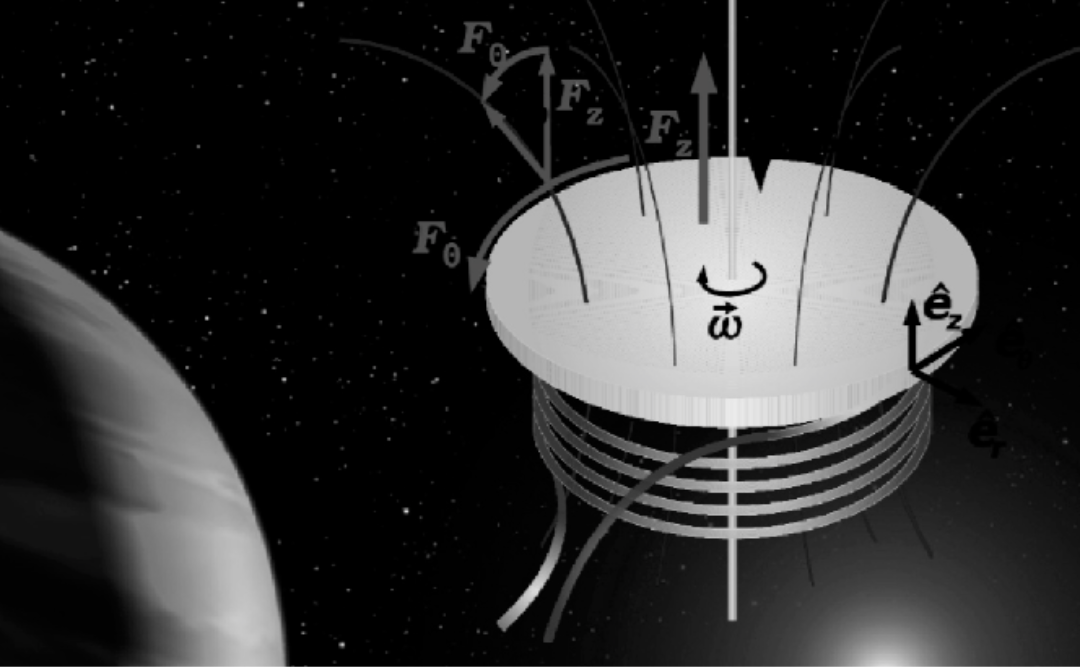In Chapter 7, “Elementary Primer of Field Propulsion Physics” of the book New Frontiers in Space Propulsion, Jochem Hauser and Walter Dröscher state that in their suggested Heim experiment for generating a gravity-like field, a reduction in the spatial dimensions of spacetime from three to two is deemed to occur (believed to be due to the material combination of Pb coil and carbon disk). See the below image.
They offer this experiment as a means to produce an axial gravity-like (acceleration) field of sufficient magnitude to serve as the basis for a propellantless propulsion system. This configuration is believed to cause an increase in the strength of the gravitational interaction accounting for the increased gravitational coupling.
The gravitational coupling constant is the product of two factors, the second of which is termed the geometric compression factor, that is, a reduction of spacetime dimensionality from three to two dimensions, possibly attributed to the presence of anyons. The strength of the extreme gravitomagnetic field might be due to the existence of anyons, a term introduced by F. Wilczek that are supposed to be generated through symmetry breaking (triggered by cryogenic temperatures or material composition).
Anyons exist only in two dimensions in spaces of type SO(2,1). Experimentally such a space might be realizable, for instance, by setting up a crystal structure that produces an energy gap in the third direction and, as long as the energy available is smaller than the energy gap the respective field can only propagate in the two other dimensions. A disk with a thin crystalline structure of carbon is suggested. But what form would the carbon take?
Carbon in the form of diamonds is not superconducting. It only becomes superconducting when doped with boron, possibly due to phonon-mediated pairing. Undoped diamond is an insulator. Carbon nanotubes have occasionally been reported as being superconducting, but definitive results are still pending. Fullerenes (ie. C60 or buckyballs) have been shown to be superconducting as solids, and fullerites of C60+ doped with alkali metals have been shown to be superconductors at temperatures as high as 31ºK (http://bohr.inesc-mn.pt/~jlm/article/46_buckyballs_EPNews.pdf).
Interestingly, “buckyballs” are found not only in the laboratory. They can be produced with simple arc welding equipment. Recently, an article has been published describing research confirming that fullerenes C60 are responsible for the light absorption of spectra from stars in very specific bands. It confirms that “buckyballs” are actively absorbing photons and are omnipresent in interstellar space. See http://physicsworld.com/cws/article/news/2015/jul/16/bountiful-buckyballs-resolve-interstellar-mystery
I bring this to light because I have long wondered if the mechanism of gravitational symmetry-breaking made possible by Cooper pairs in rotating superconductors in the laboratory could be occurring naturally in interstellar space? I have presumed that in order for gravitophotons to generate gravity-like fields naturally, that it would require the existence of superconducting materials in interstellar space. Could the carbon disc as suggested by Hauser and Dröscher be fullerene? And could that molecule play a role in what most scientists describe as “dark matter” by producing a strong gravity-like attractive field much higher than that capable of being produced by normal matter?
While interstellar space has a mean temperature of 5.8º K. It might be expected that the mean temperature between galaxies is even colder. If the gravitational phenomenon attributed to dark matter is instead the effect of gravity-like fields generated by gravitophotons, then it might be expressed more strongly just outside of galaxies where the temperatures are colder and yet the concentration of fullerenes is still relatively high. Such a distribution might appear as a haze of gravitational force just outside of a galaxy, which is where dark matter has been detected – not inside of galaxies. Within a galaxy temperatures may be too high to keep fullerenes from becoming superconducting, despite the concentration of fullerenes being higher.

